The influence of CP violation on the mass of some particles in the NMSSM
The Next to Minimal Supersymmetric Standard Model (NMSSM) is established
from the Minimal Supersymmetric Standard Model (MSSM) when a gauge chiral single
superfield Sˆ is added. The mixing of additional states leads to the appearance of the new
states which make the Higgs sector of the NMSSM changed in comparision with the
MSSM. In the NMSSM, there are seven Higgs bosons (while there are five ones in the
MSSM) with three scalar CP-even Higgs S1,2,3 (ms1< ms2< ms3), two pseudoscalar CPodd Higgs P1,2 (mP1 < mP2) and a pair of charged Higgs h. The mixing of Gauginos and
Higgsions also lead to the new states in the Neutralino and the Chargino sectors. The CP
violation in the NMSSM has the influence on the mass of the three types of particle
mentioned above. The purpose of this study is to evaluate the influence of CP violation on
the mass of the Higgs bosons, the Neutralinos and the Charginos in the NMSSM
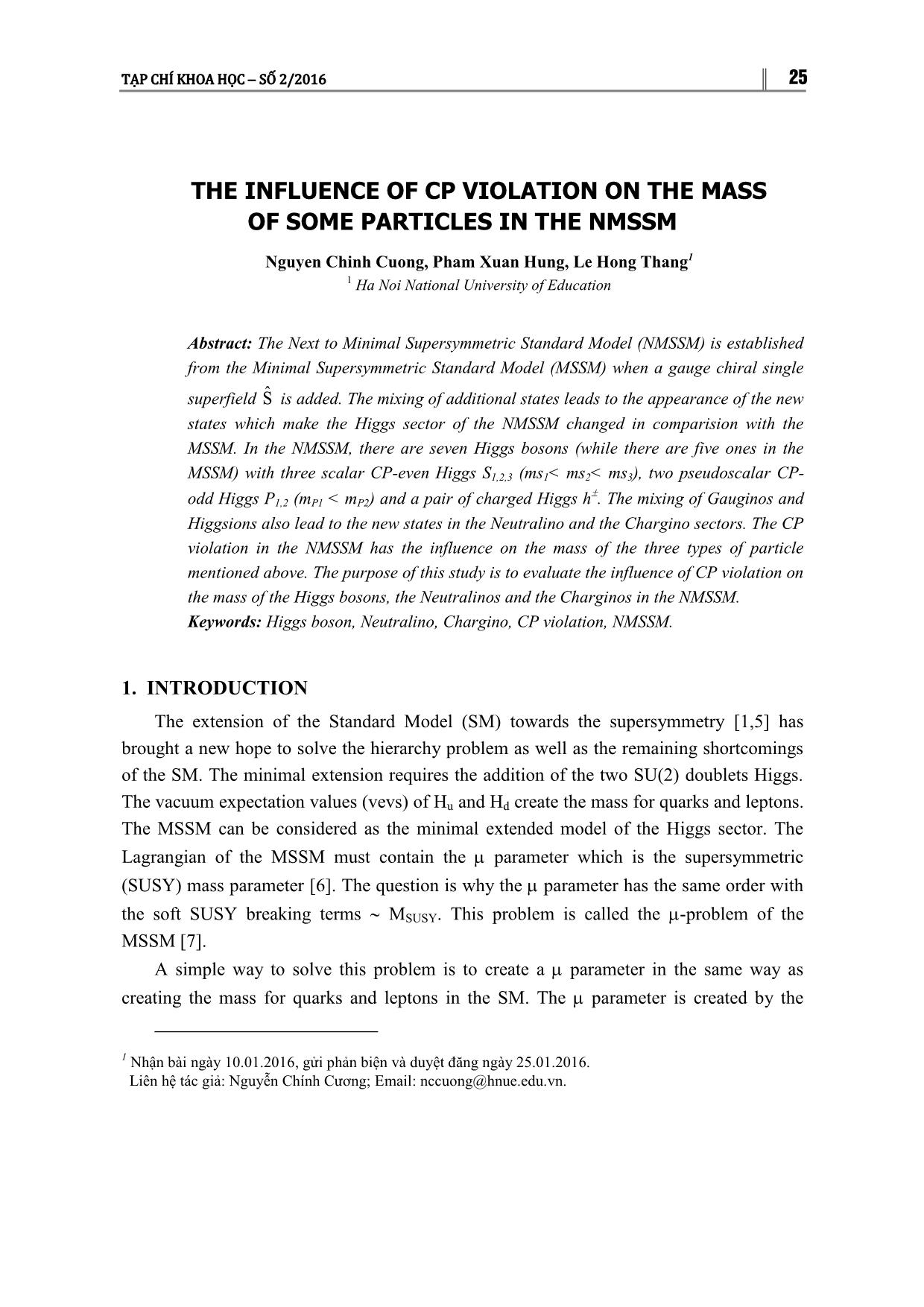
Trang 1
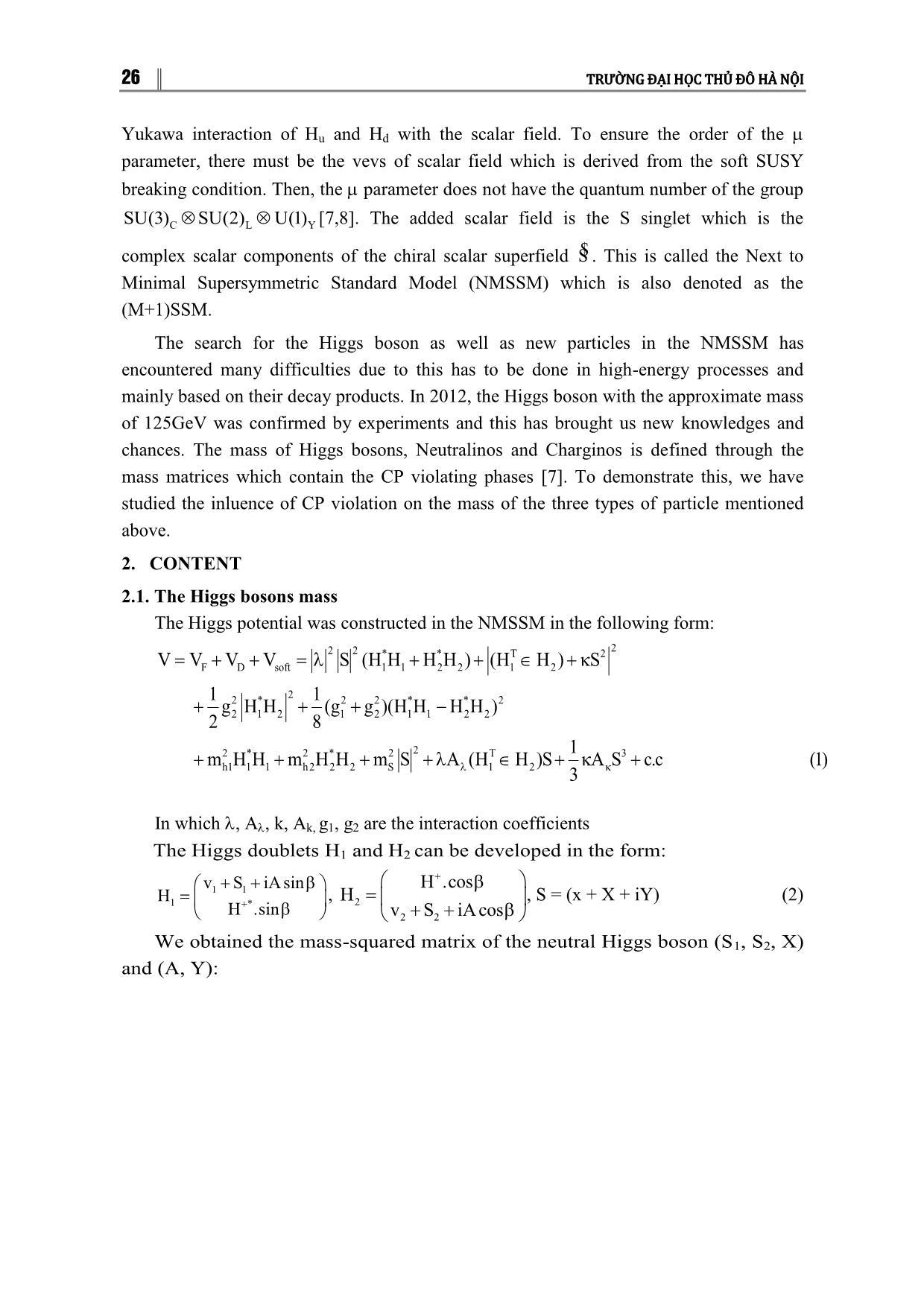
Trang 2
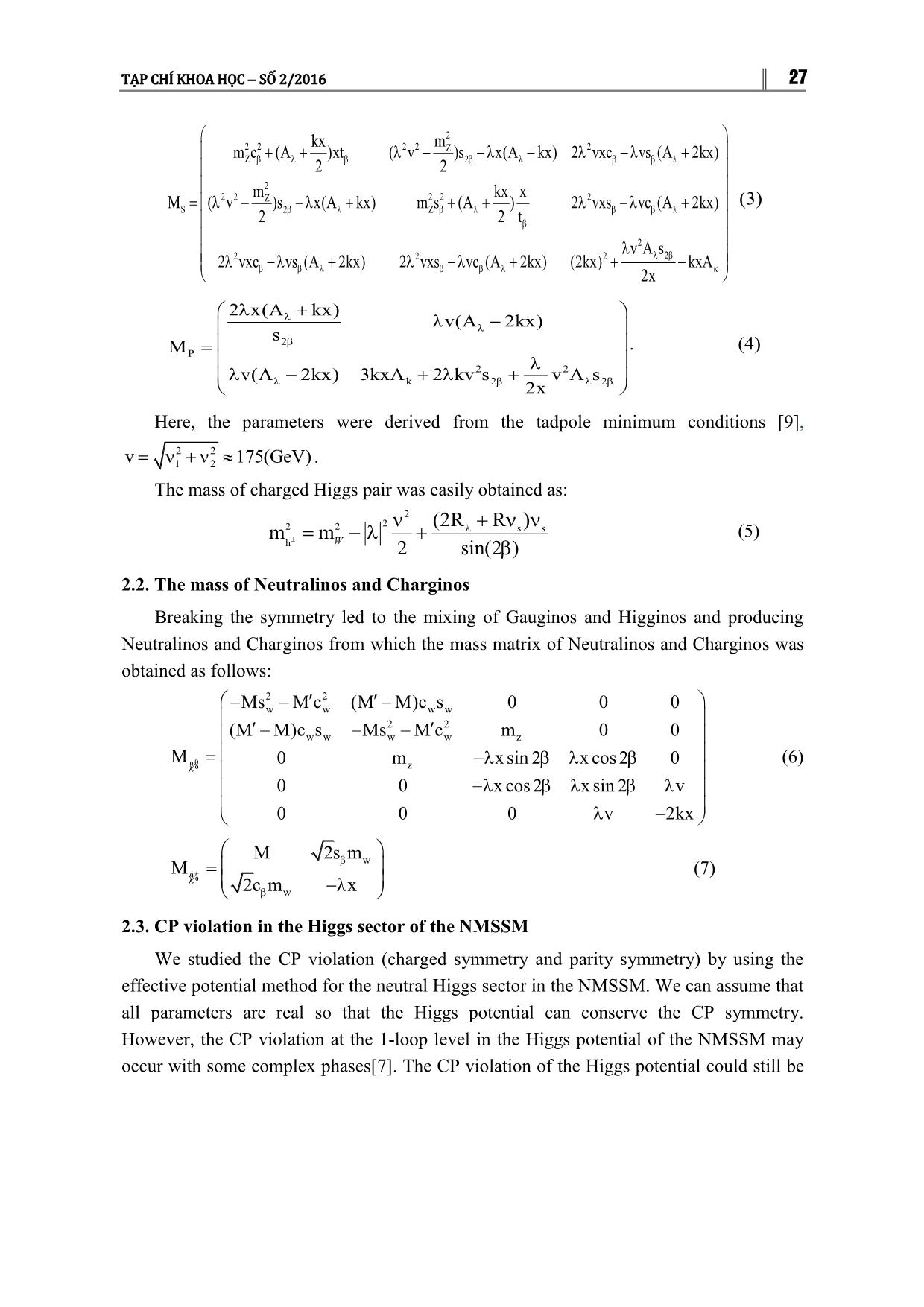
Trang 3
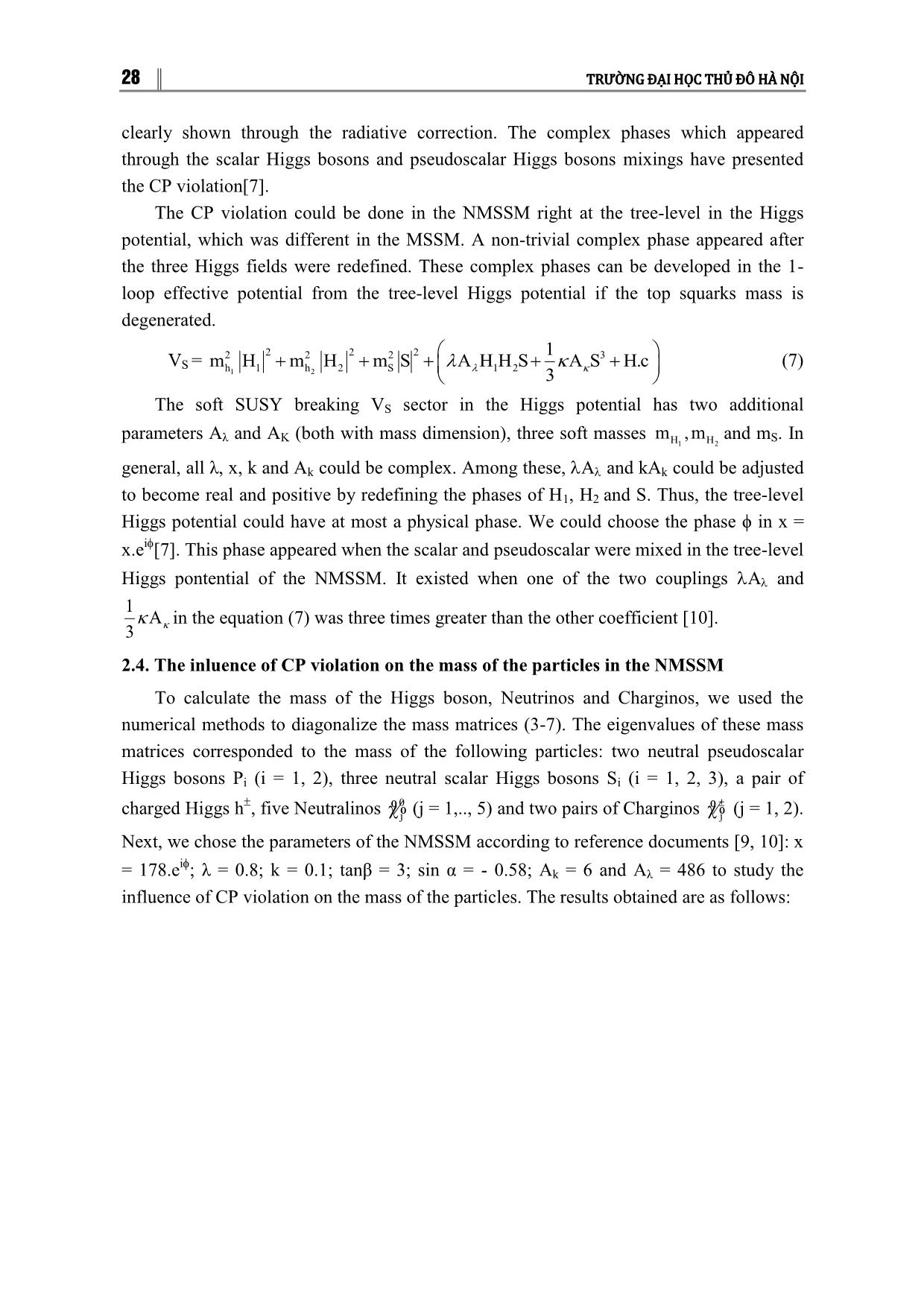
Trang 4
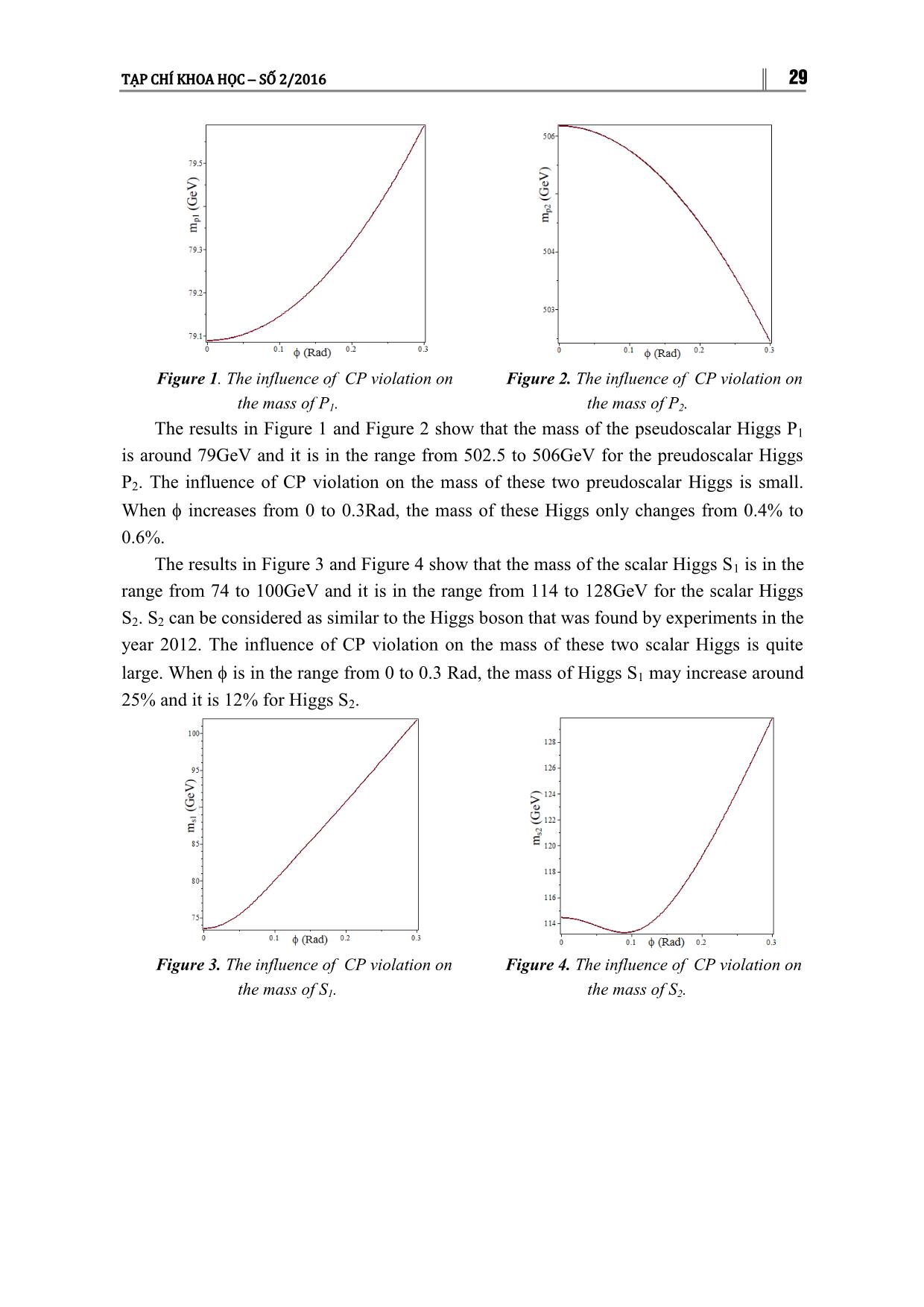
Trang 5
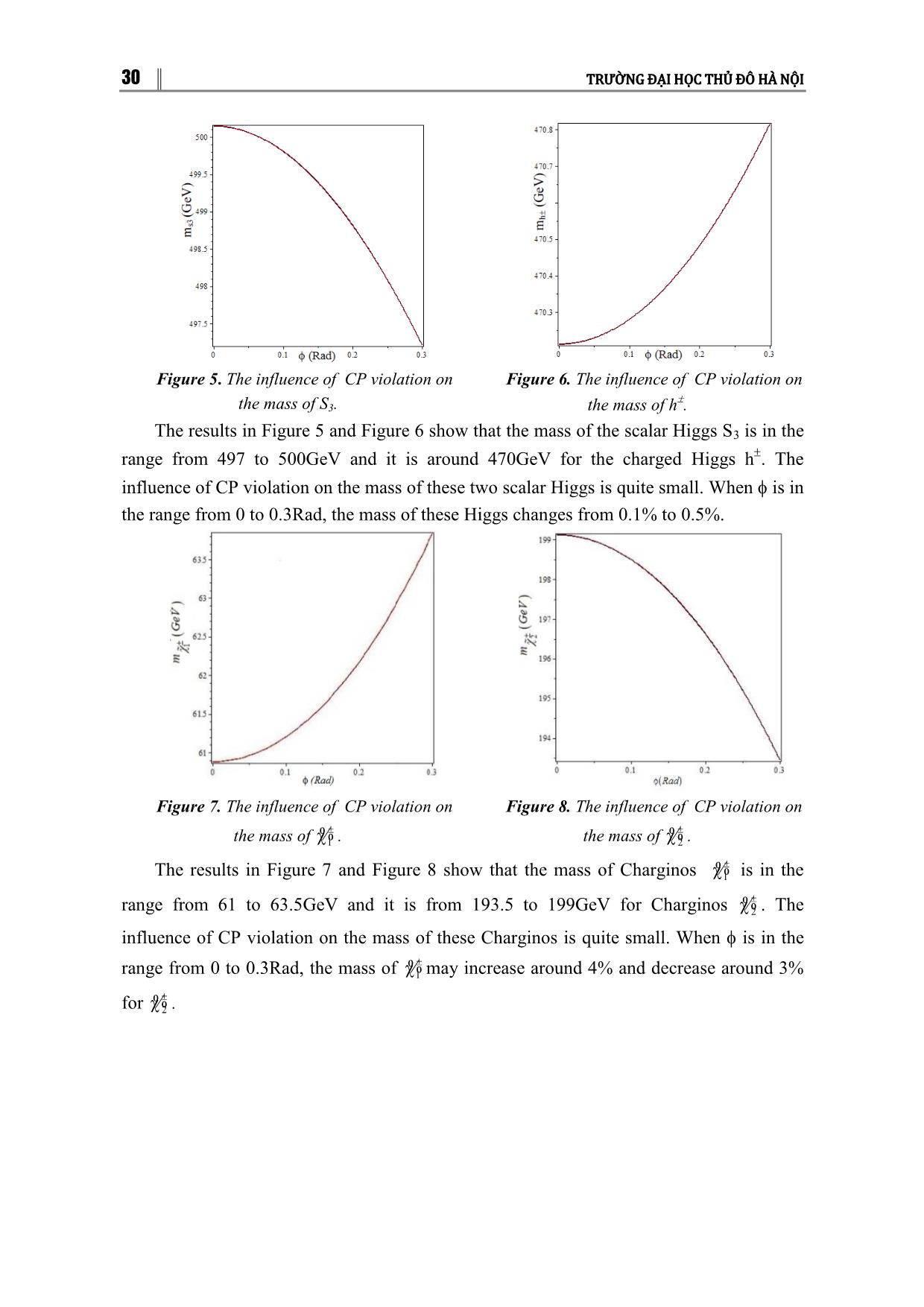
Trang 6
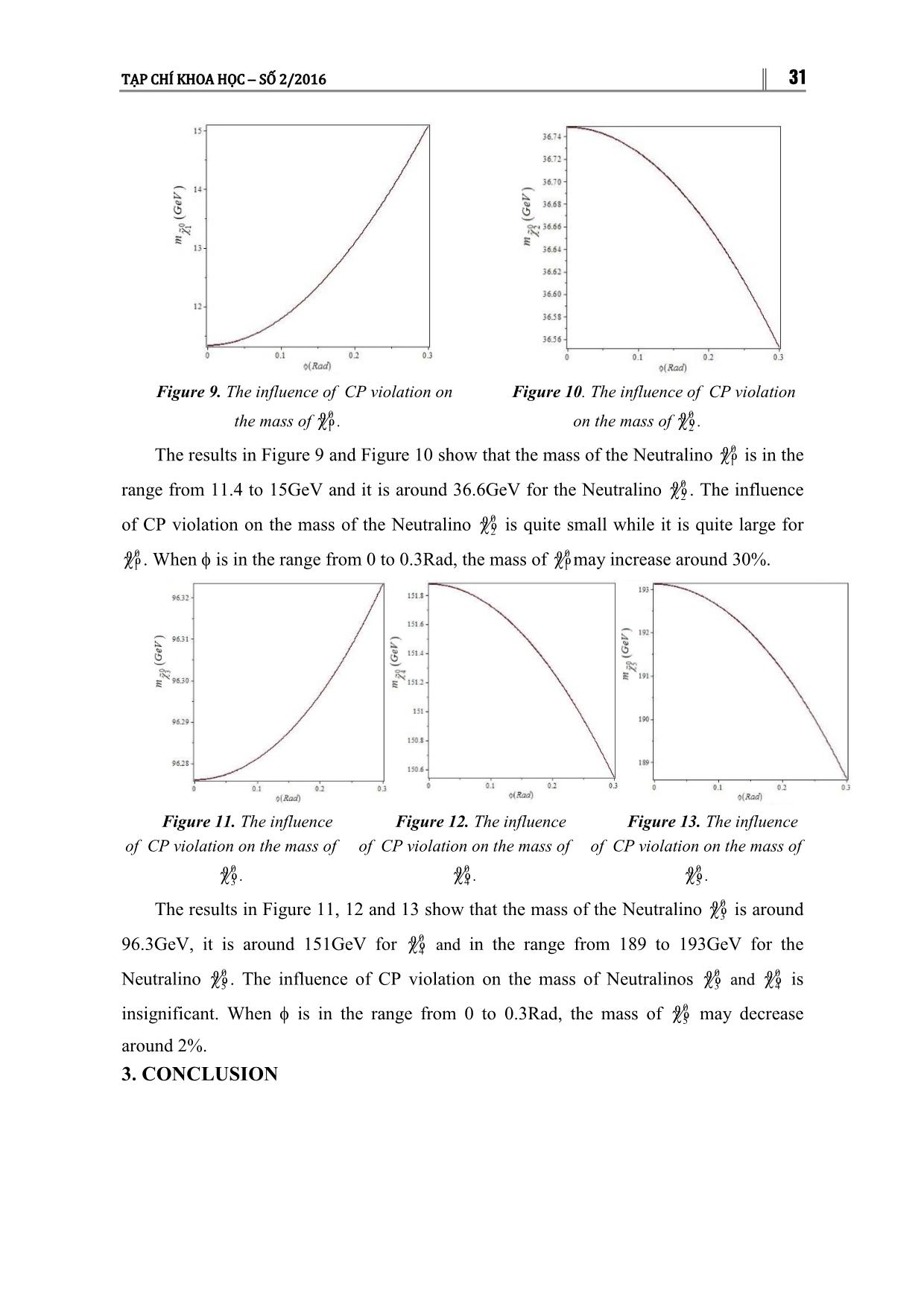
Trang 7
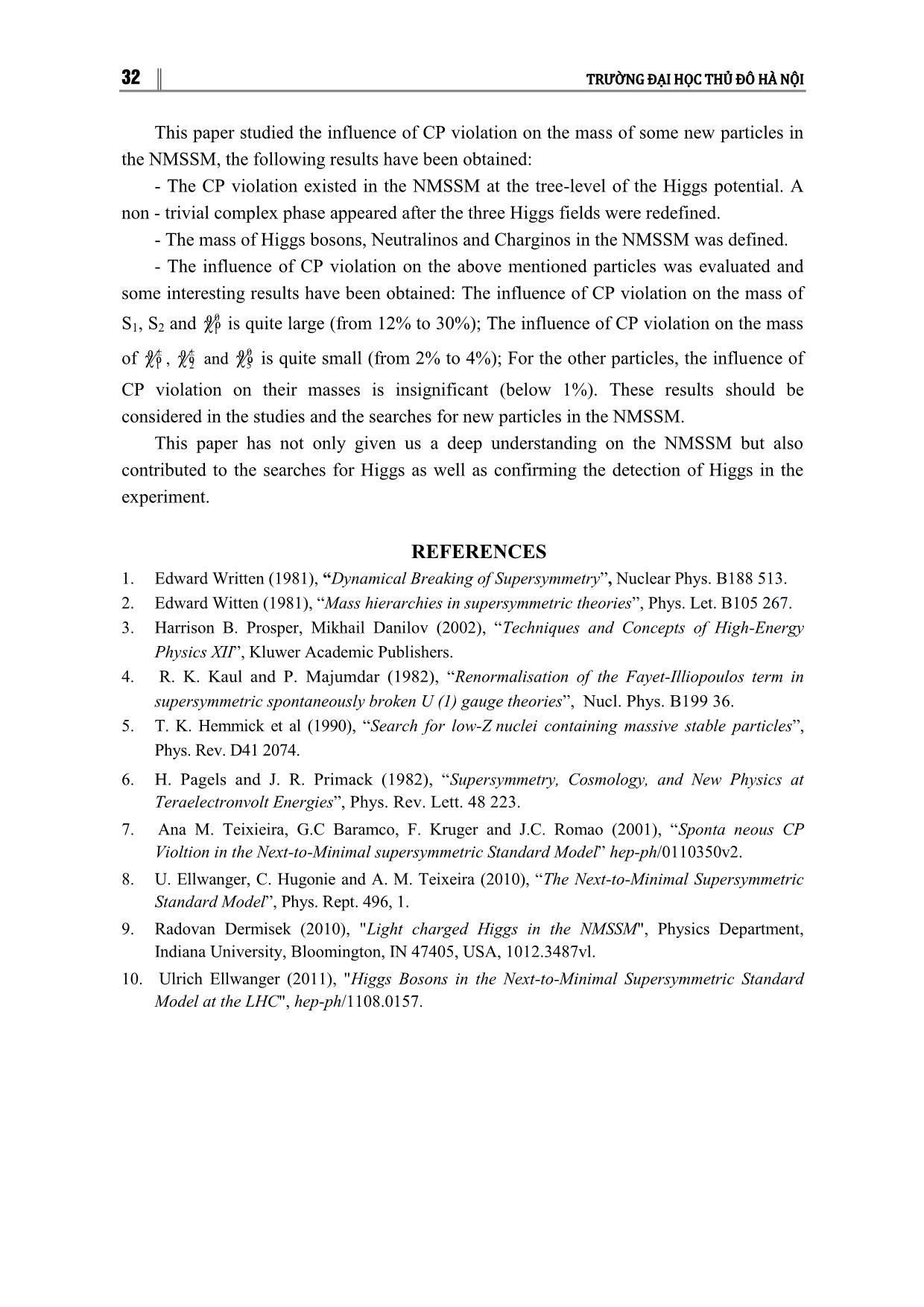
Trang 8
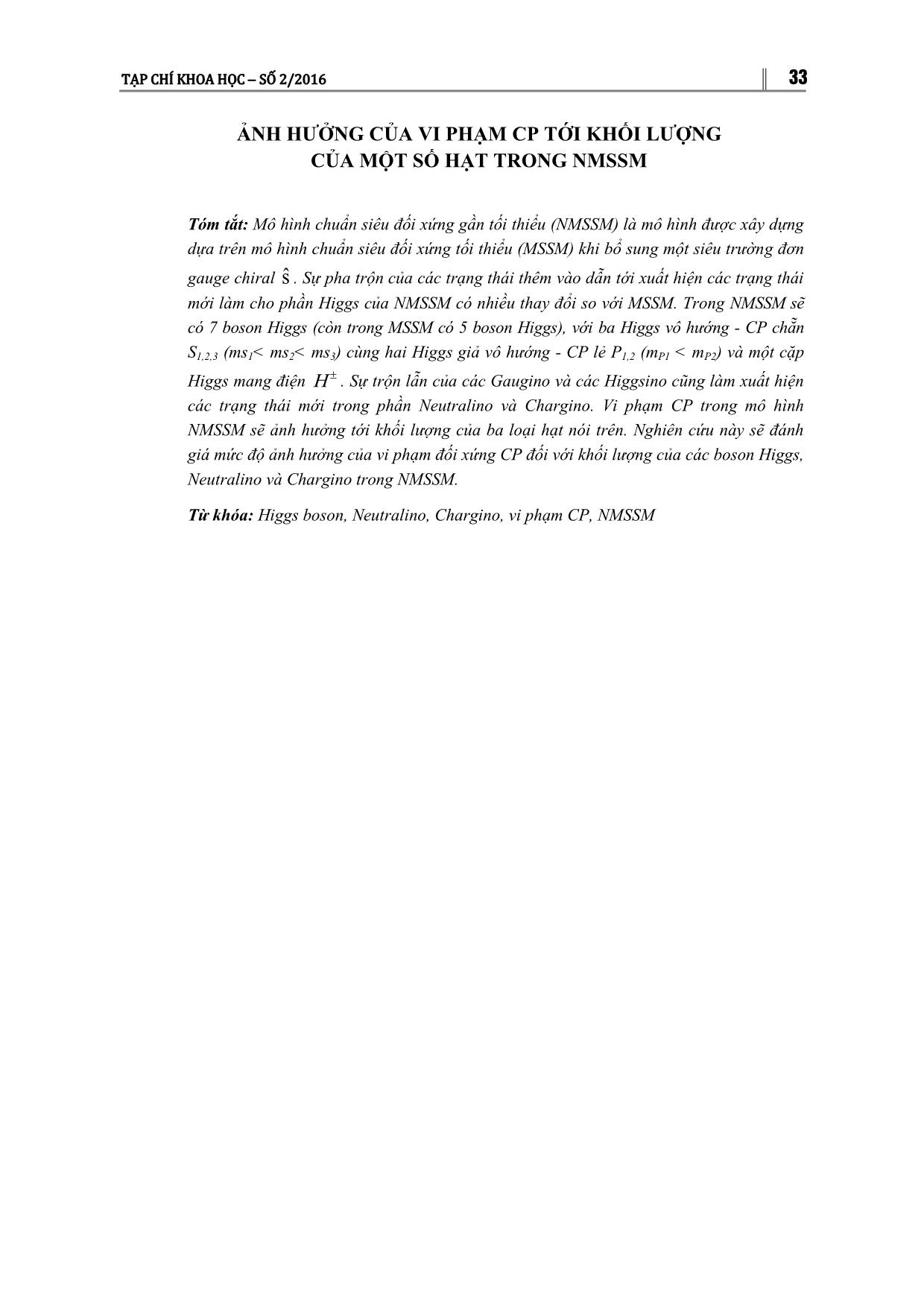
Trang 9
Tóm tắt nội dung tài liệu: The influence of CP violation on the mass of some particles in the NMSSM
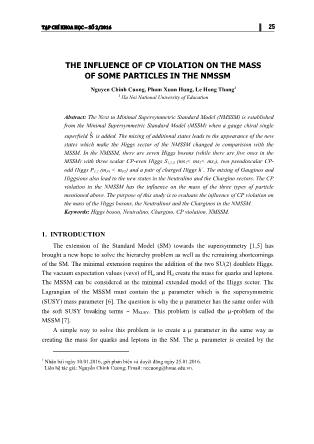
TẠP CHÍ KHOA HỌC SỐ 2/2016 25 THE INFLUENCE OF CP VIOLATION ON THE MASS OF SOME PARTICLES IN THE NMSSM Nguyen Chinh Cuong, Pham Xuan Hung, Le Hong Thang1 1 Ha Noi National University of Education Abstract: The Next to Minimal Supersymmetric Standard Model (NMSSM) is established from the Minimal Supersymmetric Standard Model (MSSM) when a gauge chiral single superfield Sˆ is added. The mixing of additional states leads to the appearance of the new states which make the Higgs sector of the NMSSM changed in comparision with the MSSM. In the NMSSM, there are seven Higgs bosons (while there are five ones in the MSSM) with three scalar CP-even Higgs S1,2,3 (ms1< ms2< ms3), two pseudoscalar CP- odd Higgs P1,2 (mP1 < mP2) and a pair of charged Higgs h . The mixing of Gauginos and Higgsions also lead to the new states in the Neutralino and the Chargino sectors. The CP violation in the NMSSM has the influence on the mass of the three types of particle mentioned above. The purpose of this study is to evaluate the influence of CP violation on the mass of the Higgs bosons, the Neutralinos and the Charginos in the NMSSM. Keywords: Higgs boson, Neutralino, Chargino, CP violation, NMSSM. 1. INTRODUCTION The extension of the Standard Model (SM) towards the supersymmetry [1,5] has brought a new hope to solve the hierarchy problem as well as the remaining shortcomings of the SM. The minimal extension requires the addition of the two SU(2) doublets Higgs. The vacuum expectation values (vevs) of Hu and Hd create the mass for quarks and leptons. The MSSM can be considered as the minimal extended model of the Higgs sector. The Lagrangian of the MSSM must contain the parameter which is the supersymmetric (SUSY) mass parameter [6]. The question is why the parameter has the same order with the soft SUSY breaking terms MSUSY. This problem is called the -problem of the MSSM [7]. A simple way to solve this problem is to create a parameter in the same way as creating the mass for quarks and leptons in the SM. The parameter is created by the 1 Nhận bài ngày 10.01.2016, gửi phản biện và duyệt đăng ngày 25.01.2016. Liên hệ tác giả: Nguyễn Chính Cương; Email: nccuong@hnue.edu.vn. 26 TRƯỜNG ĐẠI HỌC THỦ ĐÔ HÀ NỘI Yukawa interaction of Hu and Hd with the scalar field. To ensure the order of the parameter, there must be the vevs of scalar field which is derived from the soft SUSY breaking condition. Then, the parameter does not have the quantum number of the group SU(3)CLY SU(2) U(1) [7,8]. The added scalar field is the S singlet which is the complex scalar components of the chiral scalar superfield S$ . This is called the Next to Minimal Supersymmetric Standard Model (NMSSM) which is also denoted as the (M+1)SSM. The search for the Higgs boson as well as new particles in the NMSSM has encountered many difficulties due to this has to be done in high-energy processes and mainly based on their decay products. In 2012, the Higgs boson with the approximate mass of 125GeV was confirmed by experiments and this has brought us new knowledges and chances. The mass of Higgs bosons, Neutralinos and Charginos is defined through the mass matrices which contain the CP violating phases [7]. To demonstrate this, we have studied the inluence of CP violation on the mass of the three types of particle mentioned above. 2. CONTENT 2.1. The Higgs bosons mass The Higgs potential was constructed in the NMSSM in the following form: 22 * * T 2 2 VVV FDsoft V S(HHHH)(H 1122 1 H) 2 S 112 gHH2 * (g 2 g)(HH 2 * HH) * 2 282 1 2 1 2 1 1 2 2 2 1 m2 H * H m 2 H * H m 2 S A (H T H )S A S 3 c.c (1) h111 h222 S 1 2 3 In which , A, k, Ak, g1, g2 are the interaction coefficients The Higgs doublets H1 and H2 can be developed in the form: v11 S iAsin H .cos H1 * , H2 , S = (x + X + iY) (2) H .sin v22 S iAcos We obtained the mass-squared matrix of the neutral Higgs boson (S1, S2, X) and (A, Y): TẠP CHÍ KHOA HỌC SỐ 2/2016 27 2 2 2kx 2 2mZ 2 mcZ2 (A )xt (v )s x(A kx) 2vxc vs(A 2kx) 22 m2 kx x 2 2Z 2 2 2 (3) MS (v )s 2 x(A kx) ms Z (A ) 2vxs vc(A 2kx) 2 2 t v2 A s 2 2 2 2 2 vxc vs (A 2kx) 2 vxs vc (A 2kx) (2kx) kxA 2x 2 x(A kx) v(A 2kx) s 2 . (4) MP v(A 2kx) 3kxA 2 kv22 s v A s k 2 2x 2 Here, the parameters were derived from the tadpole minimum conditions [9], 22 v 12 175(GeV) . The mass of charged Higgs pair was easily obtained as: 2 2 (2R R ) mm22 ss (5) h W 2 sin(2 ) 2.2. The mass of Neutralinos and Charginos Breaking the symmetry led to the mixing of Gauginos and Higginos and producing Neutralinos and Charginos from which the mass matrix of Neutralinos and Charginos was obtained as follows: MsMc(MM)cs22 0 0 0 w w w w 22 (MM)cs w w MsMc w w m z 0 0 M 0 0 m x sin 2 x cos 2 0 (6) % z 0 0 x cos 2 x sin 2 v 0 0 0 v 2kx M 2s mw M (7) % 2c mw x 2.3. CP violation in the Higgs sector of the NMSSM We studied the CP violation (charged symmetry and parity symmetry) by using the effective potential method for the neutral Higgs sector in the NMSSM. We can assume that all parameters are real so that the Higgs potential can conserve the CP symmetry. However, the CP violation at the 1-loop level in the Higgs potential of the NMSSM may occur with some complex phases[7]. The CP violation of the Higgs potential could still be 28 TRƯỜNG ĐẠI HỌC THỦ ĐÔ HÀ NỘI clearly shown through the radiative correction. The complex phases which appeared through the scalar Higgs bosons and pseudoscalar Higgs bosons mixings have presented the CP violation[7]. The CP violation could be done in the NMSSM right at the tree-level in the Higgs potential, which was different in the MSSM. A non-trivial complex phase appeared after the three Higgs fields were redefined. These complex phases can be developed in the 1- loop effective potential from the tree-level Higgs potential if the top squarks mass is degenerated. 22 2 2 2 2 1 3 VS = mHh 1 mH h 2 mS S AHHS 1 2 ASH.c (7) 12 3 The soft SUSY breaking VS sector in the Higgs potential has two additional parameters A and A (both with mass dimension), three soft masses m ,m and m . In λ K HH12 S general, all λ, x, k and Ak could be complex. Among these, A and kAk could be adjusted to become real and positive by redefining the phases of H1, H2 and S. Thus, the tree-level Higgs potential could have at most a physical phase. We could choose the phase ϕ in x = x.ei[7]. This phase appeared when the scalar and pseudoscalar were mixed in the tree-level Higgs pontential of the NMSSM. It existed when one of the two couplings A and 1 A in the equation (7) was three times greater than the other coefficient [10]. 3 2.4. The inluence of CP violation on the mass of the particles in the NMSSM To calculate the mass of the Higgs boson, Neutrinos and Charginos, we used the numerical methods to diagonalize the mass matrices (3-7). The eigenvalues of these mass matrices corresponded to the mass of the following particles: two neutral pseudoscalar Higgs bosons Pi (i = 1, 2), three neutral scalar Higgs bosons Si (i = 1, 2, 3), a pair of 0 charged Higgs h , five Neutralinos %j (j = 1,.., 5) and two pairs of Charginos %j (j = 1, 2). Next, we chose the parameters of the NMSSM according to reference documents [9, 10]: x i = 178.e ; λ = 0.8; k = 0.1; tanβ = 3; sin α = - 0.58; Ak = 6 and Aλ = 486 to study the influence of CP violation on the mass of the particles. The results obtained are as follows: TẠP CHÍ KHOA HỌC SỐ 2/2016 29 Figure 1. The influence of CP violation on Figure 2. The influence of CP violation on the mass of P1. the mass of P2. The results in Figure 1 and Figure 2 show that the mass of the pseudoscalar Higgs P1 is around 79GeV and it is in the range from 502.5 to 506GeV for the preudoscalar Higgs P2. The influence of CP violation on the mass of these two preudoscalar Higgs is small. When increases from 0 to 0.3Rad, the mass of these Higgs only changes from 0.4% to 0.6%. The results in Figure 3 and Figure 4 show that the mass of the scalar Higgs S1 is in the range from 74 to 100GeV and it is in the range from 114 to 128GeV for the scalar Higgs S2. S2 can be considered as similar to the Higgs boson that was found by experiments in the year 2012. The influence of CP violation on the mass of these two scalar Higgs is quite large. When is in the range from 0 to 0.3 Rad, the mass of Higgs S1 may increase around 25% and it is 12% for Higgs S2. Figure 3. The influence of CP violation on Figure 4. The influence of CP violation on the mass of S1. the mass of S2. 30 TRƯỜNG ĐẠI HỌC THỦ ĐÔ HÀ NỘI Figure 5. The influence of CP violation on Figure 6. The influence of CP violation on the mass of S3. the mass of h . The results in Figure 5 and Figure 6 show that the mass of the scalar Higgs S3 is in the range from 497 to 500GeV and it is around 470GeV for the charged Higgs h . The influence of CP violation on the mass of these two scalar Higgs is quite small. When is in the range from 0 to 0.3Rad, the mass of these Higgs changes from 0.1% to 0.5%. Figure 7. The influence of CP violation on Figure 8. The influence of CP violation on the mass of %1 . the mass of %2 . The results in Figure 7 and Figure 8 show that the mass of Charginos is in the range from 61 to 63.5GeV and it is from 193.5 to 199GeV for Charginos . The influence of CP violation on the mass of these Charginos is quite small. When is in the range from 0 to 0.3Rad, the mass of may increase around 4% and decrease around 3% for . TẠP CHÍ KHOA HỌC SỐ 2/2016 31 Figure 9. The influence of CP violation on Figure 10. The influence of CP violation 0 0 the mass of %1 . on the mass of %2 . 0 The results in Figure 9 and Figure 10 show that the mass of the Neutralino %1 is in the 0 range from 11.4 to 15GeV and it is around 36.6GeV for the Neutralino %2 . The influence of CP violation on the mass of the Neutralino is quite small while it is quite large for . When is in the range from 0 to 0.3Rad, the mass of may increase around 30%. Figure 11. The influence Figure 12. The influence Figure 13. The influence of CP violation on the mass of of CP violation on the mass of of CP violation on the mass of 0 0 0 %3 . %4 . %5 . 0 The results in Figure 11, 12 and 13 show that the mass of the Neutralino %3 is around 0 96.3GeV, it is around 151GeV for %4 and in the range from 189 to 193GeV for the 0 Neutralino %5 . The influence of CP violation on the mass of Neutralinos and is 0 insignificant. When is in the range from 0 to 0.3Rad, the mass of %5 may decrease around 2%. 3. CONCLUSION 32 TRƯỜNG ĐẠI HỌC THỦ ĐÔ HÀ NỘI This paper studied the influence of CP violation on the mass of some new particles in the NMSSM, the following results have been obtained: - The CP violation existed in the NMSSM at the tree-level of the Higgs potential. A non - trivial complex phase appeared after the three Higgs fields were redefined. - The mass of Higgs bosons, Neutralinos and Charginos in the NMSSM was defined. - The influence of CP violation on the above mentioned particles was evaluated and some interesting results have been obtained: The influence of CP violation on the mass of 0 S1, S2 and %1 is quite large (from 12% to 30%); The influence of CP violation on the mass 0 of %1 , %2 and %5 is quite small (from 2% to 4%); For the other particles, the influence of CP violation on their masses is insignificant (below 1%). These results should be considered in the studies and the searches for new particles in the NMSSM. This paper has not only given us a deep understanding on the NMSSM but also contributed to the searches for Higgs as well as confirming the detection of Higgs in the experiment. REFERENCES 1. Edward Written (1981), “Dynamical Breaking of Supersymmetry”, Nuclear Phys. B188 513. 2. Edward Witten (1981), “Mass hierarchies in supersymmetric theories”, Phys. Let. B105 267. 3. Harrison B. Prosper, Mikhail Danilov (2002), “Techniques and Concepts of High-Energy Physics XII”, Kluwer Academic Publishers. 4. R. K. Kaul and P. Majumdar (1982), “Renormalisation of the Fayet-Illiopoulos term in supersymmetric spontaneously broken U (1) gauge theories”, Nucl. Phys. B199 36. 5. T. K. Hemmick et al (1990), “Search for low-Z nuclei containing massive stable particles”, Phys. Rev. D41 2074. 6. H. Pagels and J. R. Primack (1982), “Supersymmetry, Cosmology, and New Physics at Teraelectronvolt Energies”, Phys. Rev. Lett. 48 223. 7. Ana M. Teixieira, G.C Baramco, F. Kruger and J.C. Romao (2001), “Sponta neous CP Violtion in the Next-to-Minimal supersymmetric Standard Model” hep-ph/0110350v2. 8. U. Ellwanger, C. Hugonie and A. M. Teixeira (2010), “The Next-to-Minimal Supersymmetric Standard Model”, Phys. Rept. 496, 1. 9. Radovan Dermisek (2010), "Light charged Higgs in the NMSSM", Physics Department, Indiana University, Bloomington, IN 47405, USA, 1012.3487vl. 10. Ulrich Ellwanger (2011), "Higgs Bosons in the Next-to-Minimal Supersymmetric Standard Model at the LHC", hep-ph/1108.0157. TẠP CHÍ KHOA HỌC SỐ 2/2016 33 ẢNH HƯỞNG CỦA VI PHẠM CP TỚI KHỐI LƯỢNG CỦA MỘT SỐ HẠT TRONG NMSSM Tóm tắt: Mô hình chuẩn siêu đối xứng gần tối thiểu (NMSSM) là mô hình được xây dựng dựa trên mô hình chuẩn siêu đối xứng tối thiểu (MSSM) khi bổ sung một siêu trường đơn gauge chiral sˆ . Sự pha trộn của các trạng thái thêm vào dẫn tới xuất hiện các trạng thái mới làm cho phần Higgs của NMSSM có nhiều thay đổi so với MSSM. Trong NMSSM sẽ có 7 boson Higgs (còn trong MSSM có 5 boson Higgs), với ba Higgs vô hướng - CP chẵn S1,2,3 (ms1< ms2< ms3) cùng hai Higgs giả vô hướng - CP lẻ P1,2 (mP1 < mP2) và một cặp Higgs mang điện H . Sự trộn lẫn của các Gaugino và các Higgsino cũng làm xuất hiện các trạng thái mới trong phần Neutralino và Chargino. Vi phạm CP trong mô hình NMSSM sẽ ảnh hưởng tới khối lượng của ba loại hạt nói trên. Nghiên cứu này sẽ đánh giá mức độ ảnh hưởng của vi phạm đối xứng CP đối với khối lượng của các boson Higgs, Neutralino và Chargino trong NMSSM. Từ khóa: Higgs boson, Neutralino, Chargino, vi phạm CP, NMSSM
File đính kèm:
 the_influence_of_cp_violation_on_the_mass_of_some_particles.pdf
the_influence_of_cp_violation_on_the_mass_of_some_particles.pdf

